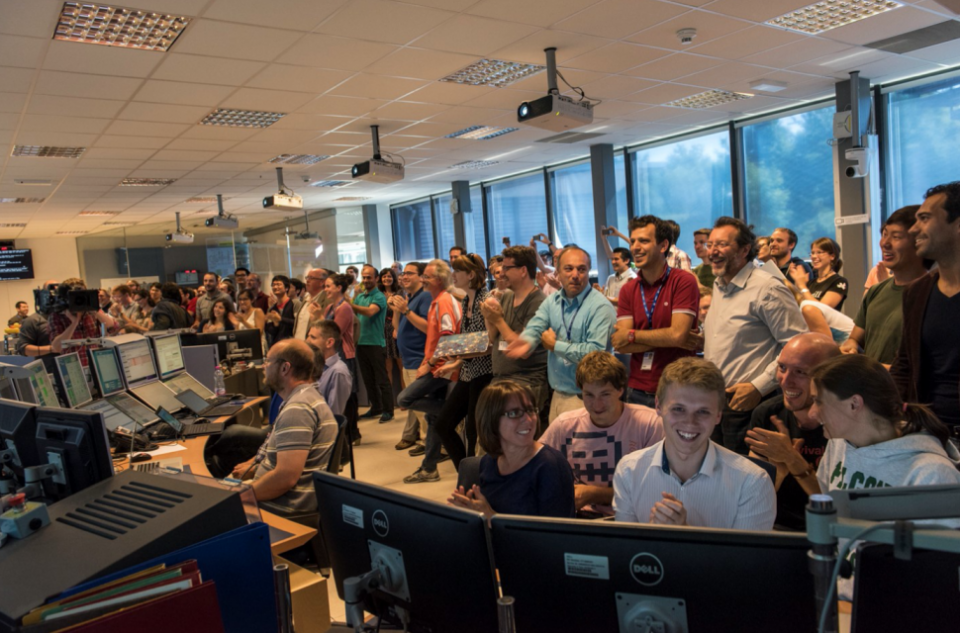Two Oxford graduate students, Will Fawcett and Will Kalderon (see first Figure: Will K standing left, Will F seated center), found themselves at the heart of a jam-packed CERN control room this morning, helping run the ATLAS experiment as the Large Hadron Collider smashed together two beams of subatomic protons, to generate the world’s highest-energy collisions. The two Wills are among 7 Oxford graduate students on attachment to the European Laboratory for Particle Physics, working on the world’s biggest experiments.
Having spent months preparing the ATLAS detector to observe the collisions, they were keen to be in control on the day the big event happened. “We'd pored over the LHC schedule back in March to try and be on shift for some of the early data taking,” says Will K, “but didn't dare to dream we'd actually be there for the very start!”. As for Will F, “we were quite nervous about the responsibility as we knew the importance of the dates -- however we never really expected everything would go to schedule as it did.”
After nearly 2 years of consolidation and upgrades the colliding proton bunches were due to be brought fully into alignment for maximum collision rate. Will K: “I'd been manning the Run Control desk overnight, when the LHC performed a few final test fills and squeezes of the beams. We made good progress overnight, and stable beams were forecast for 'early morning', so once I'd set up the ATLAS data taking run and my shift ended at 7 I handed over to Will F and sat back to enjoy the show!”
“I arrived in the control room extra early already feeling excited -- I knew what was going to happen in just a few hours’ time. Will Kalderon had already set up ATLAS in preparation for the run, so the shift changeover went smoothly,” says Will F. “As the run control shifter, we have to make sure each part of the ATLAS detector is working correctly. If any part of the detector has a problem, we have to take immediate action to try to rectify it – we try to make sure ATLAS is capable of recording data as efficiently as possible. Today, that’s an especially important task”.
Early in the morning there were two aborted attempts to achieve stable beams, which kept the whole team on edge. While the LHC team investigated what had happened, the ATLAS team waited with baited breath for the next announcement of beam injection, having no idea how long it would take. “I was flagging a bit at this point, having been up since 2pm the previous day” explains Will K, while the fresh shift crew were still keeping busy: “throughout the day I was making minor adjustments to the ATLAS setup to give us the best possible chance of recording the collisions.”
Attempt 3 began at 09:30: beams were again injected into the LHC and soon afterwards the LHC magnets started their ramp up to maximum strength. All eyes in the control room were on the graph of LHC magnetic field strength as it inched higher and higher. Eventually the automated voice announced, “beam mode flat top” at 10:06, as each of the two beams in the LHC reached maximum energy. The story wasn’t over yet, the beams had to be squeezed and then adjusted before the all-important “Stable beams” was declared. The squeeze happened at 10:29, now we’re just a few adjustments away! The room quietened, poised for the long-awaited line of text ‘stable beams’ to appear on the LHC ‘page 1’ monitor – unless something went wrong. At 10:40 on the 3rd of June 2015, stable beams in the LHC was declared, with a centre of mass energy of 13 TeV, and live displays of collisions appeared almost instantaneously on the adjacent wall. Cheers and applause erupted from the congregation filling the control room. Will F: “The atmosphere was absolutely electric, you could get a sense that years of hard work were paying off in this moment” After its long shutdown, ATLAS was taking data again.
“I was born only a few years before the commissioning of the ATLAS detector began. It’s somehow incredible, and a testament to the dedication of all the people who built the detector, that I could be the run-control shifter for ATLAS on this day. It’s really is amazing to witness a new era in high energy physics and to take actively part in exploring unreached territories!"
There’s no room for celebrations however. Will K: “We're both back in the control room again this evening and tomorrow morning to collect more data with stable beams, which we'll start analysing next week in preparation for the intensity ramp-up in a few weeks. Then, after a good night’s sleep, we have a busy summer ahead of us as we scour this exciting data for hints of new, previously unseen particles!”

